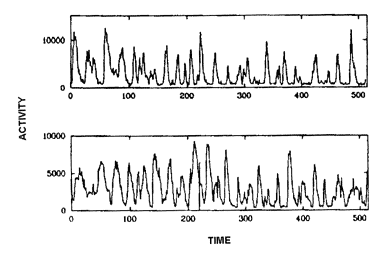 |
Science Frontiers ONLINE No. 76: Jul-Aug 1991 |
|
|
Ants as "excitable subunits"
"Abstract. Activity levels within ant colonies are monitored by using a solid-state automatically digitizing camera. The movement-activity levels of whole colonies and of isolated groups of workers are studied. Whole colonies of Leptothorax allardycei show rhythmic changes in movement-activity level. Fourier and autocorrelation analyses indicate that the activity levels of colonies are periodic, with an average period of 26 min. Single, isolated workers do not show the pattern of periodic changes in activity level. Single workers become active spontaneously, but at no particular interval. Pairs of workers, confined together, also do not show periodicity in activity level. One worker can stimulate another worker to become active, thus coupling their movement-activity patterns. As ants are placed in larger groups, the variation in the interval between activity peaks declines in a manner predicted by coupled oscillator theory. It is argued that the colony can be regarded as a population of 'excitable subunits.,"

| Activity records from two ant colonies. Time (horizontal axis) is measured in 30-second intervals. |
Comment. The author also pointed out the "formal" or mathematical similarity of the ant movement-activity levels and the dynamics of epidemics! This makes us wonder whether wars, economic cy-cles, etc. might be explained by considering humans as "excitable subunits."